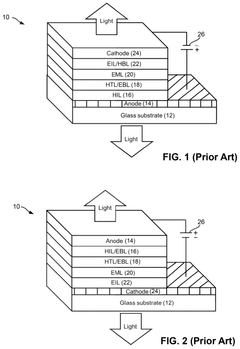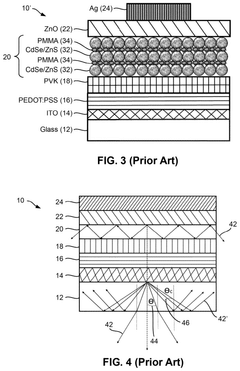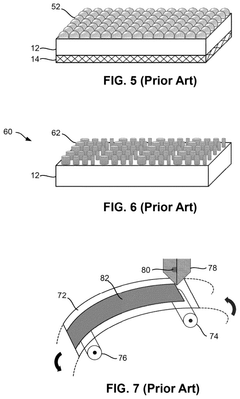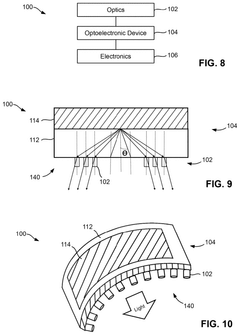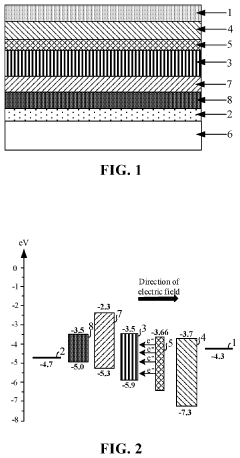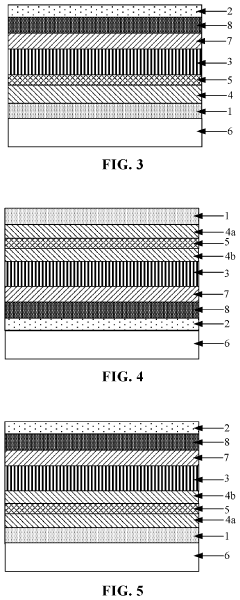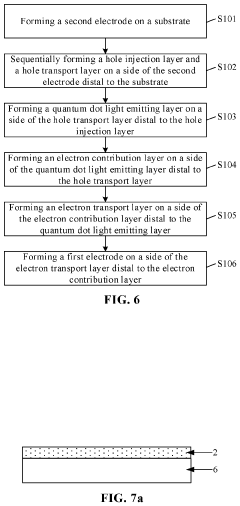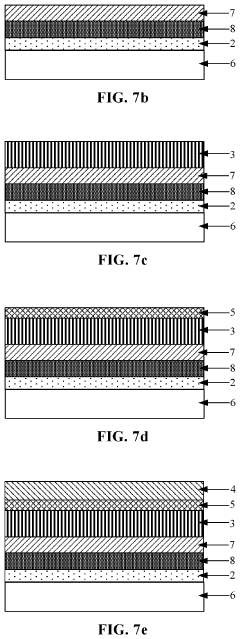The Intersection of QLED and Artificial Intelligence
JUN 19, 20259 MIN READ
Generate Your Research Report Instantly with AI Agent
Patsnap Eureka helps you evaluate technical feasibility & market potential.
QLED-AI Convergence Background and Objectives
The convergence of Quantum Dot Light-Emitting Diode (QLED) technology and Artificial Intelligence (AI) represents a significant leap forward in display technology and intelligent systems. This intersection has emerged as a result of the rapid advancements in both fields over the past decade, driven by the increasing demand for high-quality, energy-efficient displays and the growing capabilities of AI in image processing and optimization.
QLED technology, first introduced in the early 2010s, has revolutionized the display industry by offering superior color accuracy, brightness, and energy efficiency compared to traditional LED and OLED displays. The use of quantum dots, nanoscale semiconductor particles, allows for precise control of light emission, resulting in vibrant and lifelike images. As QLED displays have evolved, they have become increasingly sophisticated, incorporating features such as local dimming and enhanced color gamuts.
Concurrently, AI has made remarkable strides in various domains, including computer vision, machine learning, and neural networks. These advancements have led to significant improvements in image recognition, enhancement, and generation. The application of AI in display technology has opened up new possibilities for optimizing image quality, reducing power consumption, and enhancing user experiences.
The convergence of QLED and AI aims to leverage the strengths of both technologies to create next-generation display systems that are not only visually stunning but also intelligent and adaptive. This intersection seeks to address several key objectives in the field of display technology:
1. Enhanced Image Quality: By combining QLED's superior color reproduction capabilities with AI-driven image processing algorithms, the goal is to achieve unprecedented levels of image quality, including improved contrast, sharpness, and color accuracy.
2. Adaptive Display Performance: AI can be utilized to analyze content and viewing conditions in real-time, allowing QLED displays to dynamically adjust their settings for optimal performance and energy efficiency.
3. Personalized Viewing Experiences: The integration of AI enables displays to learn user preferences and viewing habits, tailoring the visual output to individual users for a more personalized and engaging experience.
4. Advanced Content Creation: The combination of QLED and AI technologies can facilitate the development of new tools and techniques for content creators, enabling them to produce more immersive and visually striking content.
5. Energy Efficiency: By leveraging AI to optimize display parameters and power consumption, the convergence aims to further improve the energy efficiency of QLED displays, addressing environmental concerns and reducing operating costs.
As research and development in this field progress, the intersection of QLED and AI is expected to drive innovation in various sectors, including consumer electronics, professional displays, and emerging technologies such as augmented and virtual reality. This convergence represents a promising direction for the future of display technology, with the potential to redefine visual experiences across multiple applications and industries.
QLED technology, first introduced in the early 2010s, has revolutionized the display industry by offering superior color accuracy, brightness, and energy efficiency compared to traditional LED and OLED displays. The use of quantum dots, nanoscale semiconductor particles, allows for precise control of light emission, resulting in vibrant and lifelike images. As QLED displays have evolved, they have become increasingly sophisticated, incorporating features such as local dimming and enhanced color gamuts.
Concurrently, AI has made remarkable strides in various domains, including computer vision, machine learning, and neural networks. These advancements have led to significant improvements in image recognition, enhancement, and generation. The application of AI in display technology has opened up new possibilities for optimizing image quality, reducing power consumption, and enhancing user experiences.
The convergence of QLED and AI aims to leverage the strengths of both technologies to create next-generation display systems that are not only visually stunning but also intelligent and adaptive. This intersection seeks to address several key objectives in the field of display technology:
1. Enhanced Image Quality: By combining QLED's superior color reproduction capabilities with AI-driven image processing algorithms, the goal is to achieve unprecedented levels of image quality, including improved contrast, sharpness, and color accuracy.
2. Adaptive Display Performance: AI can be utilized to analyze content and viewing conditions in real-time, allowing QLED displays to dynamically adjust their settings for optimal performance and energy efficiency.
3. Personalized Viewing Experiences: The integration of AI enables displays to learn user preferences and viewing habits, tailoring the visual output to individual users for a more personalized and engaging experience.
4. Advanced Content Creation: The combination of QLED and AI technologies can facilitate the development of new tools and techniques for content creators, enabling them to produce more immersive and visually striking content.
5. Energy Efficiency: By leveraging AI to optimize display parameters and power consumption, the convergence aims to further improve the energy efficiency of QLED displays, addressing environmental concerns and reducing operating costs.
As research and development in this field progress, the intersection of QLED and AI is expected to drive innovation in various sectors, including consumer electronics, professional displays, and emerging technologies such as augmented and virtual reality. This convergence represents a promising direction for the future of display technology, with the potential to redefine visual experiences across multiple applications and industries.
Market Analysis for AI-Enhanced QLED Displays
The market for AI-enhanced QLED displays is experiencing rapid growth and transformation, driven by the convergence of Quantum Dot Light Emitting Diode (QLED) technology and artificial intelligence. This intersection is creating new opportunities and reshaping consumer expectations in the display industry.
QLED technology, known for its superior color reproduction and brightness, has already gained significant traction in the premium TV market. The integration of AI capabilities is further enhancing the appeal of QLED displays, offering features such as intelligent content optimization, adaptive brightness control, and personalized viewing experiences.
The global QLED TV market size was valued at $8.5 billion in 2020 and is projected to reach $25.6 billion by 2027, growing at a CAGR of 21.3% during the forecast period. The addition of AI features is expected to accelerate this growth trajectory, as consumers increasingly seek smart, connected display solutions.
Key market segments for AI-enhanced QLED displays include high-end consumer televisions, professional monitors for content creation and gaming, digital signage, and emerging applications in automotive infotainment systems. The consumer TV segment currently dominates the market, but rapid growth is anticipated in commercial and industrial applications.
Geographically, North America and Asia-Pacific are the leading markets for AI-enhanced QLED displays. North America benefits from early technology adoption and high consumer spending on premium electronics. Asia-Pacific, particularly China and South Korea, is driven by the presence of major manufacturers and a growing middle-class consumer base.
The competitive landscape is characterized by intense rivalry among established electronics giants and emerging display technology companies. Key players include Samsung Electronics, TCL Technology, and LG Electronics, who are investing heavily in R&D to integrate AI capabilities into their QLED product lines.
Consumer demand for AI-enhanced QLED displays is fueled by several factors, including the desire for immersive viewing experiences, energy efficiency, and smart home integration. The ability of AI to optimize picture quality in real-time, adjust settings based on ambient conditions, and provide personalized content recommendations is particularly appealing to tech-savvy consumers.
In the commercial sector, the demand is driven by the need for high-quality, reliable displays capable of operating in diverse environments. AI-enhanced QLED displays offer advantages in digital signage, control rooms, and professional video production, where image quality and system intelligence are critical.
Looking ahead, the market for AI-enhanced QLED displays is poised for continued growth. Technological advancements, such as improved quantum dot materials and more sophisticated AI algorithms, are expected to further enhance performance and expand applications. The integration with other emerging technologies, like 5G and IoT, will likely create new market opportunities and use cases for these advanced display systems.
QLED technology, known for its superior color reproduction and brightness, has already gained significant traction in the premium TV market. The integration of AI capabilities is further enhancing the appeal of QLED displays, offering features such as intelligent content optimization, adaptive brightness control, and personalized viewing experiences.
The global QLED TV market size was valued at $8.5 billion in 2020 and is projected to reach $25.6 billion by 2027, growing at a CAGR of 21.3% during the forecast period. The addition of AI features is expected to accelerate this growth trajectory, as consumers increasingly seek smart, connected display solutions.
Key market segments for AI-enhanced QLED displays include high-end consumer televisions, professional monitors for content creation and gaming, digital signage, and emerging applications in automotive infotainment systems. The consumer TV segment currently dominates the market, but rapid growth is anticipated in commercial and industrial applications.
Geographically, North America and Asia-Pacific are the leading markets for AI-enhanced QLED displays. North America benefits from early technology adoption and high consumer spending on premium electronics. Asia-Pacific, particularly China and South Korea, is driven by the presence of major manufacturers and a growing middle-class consumer base.
The competitive landscape is characterized by intense rivalry among established electronics giants and emerging display technology companies. Key players include Samsung Electronics, TCL Technology, and LG Electronics, who are investing heavily in R&D to integrate AI capabilities into their QLED product lines.
Consumer demand for AI-enhanced QLED displays is fueled by several factors, including the desire for immersive viewing experiences, energy efficiency, and smart home integration. The ability of AI to optimize picture quality in real-time, adjust settings based on ambient conditions, and provide personalized content recommendations is particularly appealing to tech-savvy consumers.
In the commercial sector, the demand is driven by the need for high-quality, reliable displays capable of operating in diverse environments. AI-enhanced QLED displays offer advantages in digital signage, control rooms, and professional video production, where image quality and system intelligence are critical.
Looking ahead, the market for AI-enhanced QLED displays is poised for continued growth. Technological advancements, such as improved quantum dot materials and more sophisticated AI algorithms, are expected to further enhance performance and expand applications. The integration with other emerging technologies, like 5G and IoT, will likely create new market opportunities and use cases for these advanced display systems.
QLED and AI Integration: Current State and Challenges
The integration of QLED (Quantum Dot Light-Emitting Diode) technology and Artificial Intelligence (AI) represents a cutting-edge intersection in display technology and smart systems. Currently, this integration faces several challenges and opportunities that define its state of development.
QLED technology has made significant strides in recent years, offering superior color reproduction, brightness, and energy efficiency compared to traditional LED displays. However, the integration of AI into QLED systems is still in its early stages, with researchers and manufacturers exploring various approaches to enhance display performance and user experience.
One of the primary challenges in QLED and AI integration lies in developing algorithms that can effectively optimize display parameters in real-time. This includes adjusting color accuracy, contrast, and brightness based on ambient lighting conditions and content being displayed. While some progress has been made in this area, achieving seamless and accurate adaptations remains a significant hurdle.
Another challenge is the implementation of AI-driven content enhancement for QLED displays. This involves developing machine learning models capable of upscaling low-resolution content, reducing noise, and improving overall image quality. While AI-based upscaling technologies exist, their integration with QLED's unique color reproduction capabilities presents both opportunities and complexities.
Power consumption is a critical concern in the integration of AI with QLED technology. As AI algorithms require substantial computational resources, balancing the enhanced functionality with energy efficiency is a major challenge. Researchers are exploring ways to optimize AI models for low-power operation without compromising on performance.
The current state of QLED and AI integration also includes efforts to incorporate voice and gesture recognition systems. These AI-powered interfaces aim to provide more intuitive and interactive user experiences. However, challenges remain in terms of accuracy, responsiveness, and seamless integration with QLED display systems.
Data privacy and security present another significant challenge in the convergence of QLED and AI. As displays become smarter and more connected, ensuring the protection of user data and preventing unauthorized access to AI-enhanced systems becomes increasingly important.
Despite these challenges, the integration of QLED and AI shows promising advancements. Some manufacturers have already introduced AI-enhanced QLED TVs that offer improved picture quality and smart features. However, the full potential of this integration, particularly in areas such as personalized content recommendations and advanced user interfaces, is yet to be realized.
QLED technology has made significant strides in recent years, offering superior color reproduction, brightness, and energy efficiency compared to traditional LED displays. However, the integration of AI into QLED systems is still in its early stages, with researchers and manufacturers exploring various approaches to enhance display performance and user experience.
One of the primary challenges in QLED and AI integration lies in developing algorithms that can effectively optimize display parameters in real-time. This includes adjusting color accuracy, contrast, and brightness based on ambient lighting conditions and content being displayed. While some progress has been made in this area, achieving seamless and accurate adaptations remains a significant hurdle.
Another challenge is the implementation of AI-driven content enhancement for QLED displays. This involves developing machine learning models capable of upscaling low-resolution content, reducing noise, and improving overall image quality. While AI-based upscaling technologies exist, their integration with QLED's unique color reproduction capabilities presents both opportunities and complexities.
Power consumption is a critical concern in the integration of AI with QLED technology. As AI algorithms require substantial computational resources, balancing the enhanced functionality with energy efficiency is a major challenge. Researchers are exploring ways to optimize AI models for low-power operation without compromising on performance.
The current state of QLED and AI integration also includes efforts to incorporate voice and gesture recognition systems. These AI-powered interfaces aim to provide more intuitive and interactive user experiences. However, challenges remain in terms of accuracy, responsiveness, and seamless integration with QLED display systems.
Data privacy and security present another significant challenge in the convergence of QLED and AI. As displays become smarter and more connected, ensuring the protection of user data and preventing unauthorized access to AI-enhanced systems becomes increasingly important.
Despite these challenges, the integration of QLED and AI shows promising advancements. Some manufacturers have already introduced AI-enhanced QLED TVs that offer improved picture quality and smart features. However, the full potential of this integration, particularly in areas such as personalized content recommendations and advanced user interfaces, is yet to be realized.
Current AI-Driven QLED Enhancement Solutions
01 QLED structure and composition
QLED devices typically consist of a quantum dot layer sandwiched between electron and hole transport layers. The quantum dots are usually made of semiconductor nanocrystals that emit light when electrically excited. The composition and structure of these layers are crucial for device performance, including efficiency and color purity.- Quantum dot structure and composition: QLED technology utilizes quantum dots, which are semiconductor nanocrystals. The structure and composition of these quantum dots are crucial for the performance of QLEDs. Researchers focus on developing various quantum dot materials and structures to enhance light emission efficiency, color purity, and stability.
- QLED device architecture: The design and architecture of QLED devices play a significant role in their performance. This includes the arrangement of layers such as the electron transport layer, hole transport layer, and quantum dot emissive layer. Innovations in device architecture aim to improve efficiency, reduce power consumption, and enhance overall display quality.
- Manufacturing processes for QLEDs: Advancements in manufacturing processes are essential for the commercialization of QLED technology. This includes techniques for depositing quantum dots, creating uniform layers, and integrating QLEDs into display panels. Researchers are developing novel methods to improve production efficiency and reduce costs while maintaining high-quality standards.
- Color tuning and light management: QLED technology offers advantages in color reproduction and light management. Innovations in this area focus on optimizing the spectral output of quantum dots, enhancing color gamut, and improving light extraction efficiency. This includes developing new quantum dot materials and implementing advanced optical designs.
- Integration with other display technologies: Researchers are exploring ways to integrate QLED technology with other display technologies to create hybrid solutions. This includes combining QLEDs with OLEDs, micro-LEDs, or traditional LCD technology to leverage the strengths of each approach. The goal is to develop displays with improved performance, efficiency, and versatility.
02 Quantum dot synthesis and modification
The synthesis and modification of quantum dots play a vital role in QLED performance. Techniques for producing high-quality quantum dots with specific optical properties, as well as methods for surface modification to improve stability and efficiency, are key areas of research and development in QLED technology.Expand Specific Solutions03 QLED display applications
QLEDs are increasingly being used in display applications, offering advantages such as high color gamut, brightness, and energy efficiency. Innovations in this area include methods for integrating QLEDs into various display architectures, addressing challenges related to color accuracy, and improving overall display performance.Expand Specific Solutions04 QLED manufacturing processes
Advancements in manufacturing processes for QLEDs are crucial for commercialization. This includes developing scalable production methods, improving deposition techniques for quantum dot layers, and enhancing overall device fabrication processes to increase yield and reduce costs.Expand Specific Solutions05 QLED efficiency and lifetime improvements
Ongoing research focuses on improving the efficiency and lifetime of QLED devices. This involves optimizing the quantum dot materials, enhancing charge injection and transport, reducing energy loss mechanisms, and developing strategies to mitigate degradation processes that affect long-term stability.Expand Specific Solutions
Key Players in QLED-AI Display Industry
The intersection of QLED and AI represents an emerging field in display technology, currently in its early growth stage. The market size is expanding rapidly, driven by increasing demand for high-quality displays in various sectors. Technologically, it's progressing from experimental to early commercial applications. Companies like BOE Technology Group, Sharp Corp., and LG Electronics are at the forefront, developing AI-enhanced QLED solutions. Research institutions such as MIT and Tsinghua University are contributing to fundamental advancements. While established players like Apple and Huawei are exploring integration possibilities, startups and specialized firms like Guangzhou ChinaRay Optoelectronic Materials are also making significant strides. The competitive landscape is dynamic, with both hardware manufacturers and AI companies vying for market share in this promising domain.
BOE Technology Group Co., Ltd.
Technical Solution: BOE has developed an AI-enhanced QLED display technology that integrates machine learning algorithms to optimize color accuracy, contrast, and energy efficiency. Their system uses real-time image processing to adjust pixel-level quantum dot excitation based on content and ambient light conditions. This allows for dynamic color gamut mapping and localized dimming, resulting in improved picture quality and reduced power consumption. BOE's AI chip embedded in the display panel also enables advanced features like object recognition and scene-adaptive rendering.
Strengths: Industry-leading QLED manufacturing capabilities, strong R&D in AI-display integration. Weaknesses: Potential high costs, reliance on external AI chip suppliers.
Shenzhen China Star Optoelectronics Semicon Display Tech Co.
Technical Solution: China Star Optoelectronics (CSO) has been working on integrating AI capabilities into their QLED display technology. Their approach focuses on using machine learning algorithms to optimize quantum dot performance and color accuracy. CSO's system employs neural networks to analyze input signals and adjust quantum dot excitation parameters in real-time, resulting in improved color gamut and energy efficiency. They are also developing AI-driven local dimming techniques to enhance contrast ratios and reduce power consumption in their QLED panels.
Strengths: Strong manufacturing capabilities, growing expertise in AI-display integration. Weaknesses: Less established brand compared to some competitors, potential limitations in AI chip sourcing.
Core Innovations in QLED-AI Integration
Integrated optoelectronic devices for lighting and display applications
PatentPendingUS20240341118A1
Innovation
- Incorporation of metasurfaces with two-dimensional arrays of nanostructures into the light-emitting devices to reduce photon reflection, control light direction, and manipulate emission profiles, combined with machine-learning methods for optimizing light patterns and using flexible substrates like hybrid silver nanowires and carbon nanotubes for improved conductivity and stability.
Quantum dot light emitting diode, manufacturing method thereof and display panel with electron contribution layer for injecting free electrons to light emitting layer
PatentActiveUS11974448B2
Innovation
- Incorporating a metal electron contribution layer with a work function less than 4 eV, such as magnesium, lithium, or cesium, between the electron transport layer and the quantum dot light emitting layer to enhance electron injection, thereby balancing carrier injection and improving light emitting efficiency and service life.
Energy Efficiency and Sustainability Considerations
The intersection of QLED (Quantum Dot Light-Emitting Diode) technology and Artificial Intelligence (AI) presents significant opportunities for enhancing energy efficiency and sustainability in display technologies. QLED displays, known for their superior color reproduction and brightness, are already more energy-efficient than traditional LED displays. However, the integration of AI can further optimize their performance and reduce energy consumption.
AI algorithms can dynamically adjust the brightness and color output of QLED displays based on ambient lighting conditions and content being displayed. This adaptive control mechanism ensures that the display uses only the necessary amount of energy to produce optimal visual quality, thereby reducing overall power consumption. Machine learning models can analyze viewing patterns and user preferences to predict and pre-emptively adjust display settings, further enhancing energy efficiency.
The use of AI in QLED manufacturing processes can also contribute to sustainability efforts. Intelligent systems can optimize production lines, reducing waste and improving resource utilization. AI-driven quality control can detect defects early in the manufacturing process, minimizing the production of faulty units and conserving resources. Additionally, AI can assist in the design of more efficient quantum dot structures, potentially leading to displays that require less energy to operate.
Lifecycle management of QLED displays can be significantly improved through AI integration. Predictive maintenance algorithms can monitor display performance and anticipate potential issues, extending the lifespan of devices and reducing electronic waste. AI can also optimize the recycling process for QLED displays, identifying the most efficient methods for recovering and reusing valuable materials.
The combination of QLED and AI technologies also opens up possibilities for smart power management in larger display systems, such as those used in public spaces or commercial environments. AI-powered systems can coordinate multiple displays, adjusting their collective output based on factors like time of day, foot traffic, and energy grid demands, contributing to more sustainable urban infrastructures.
As the development of QLED technology continues, AI will play a crucial role in pushing the boundaries of energy efficiency. Future iterations of QLED displays may incorporate on-device AI processors specifically designed to manage power consumption and display quality in real-time, further reducing the energy footprint of these devices while maintaining or even improving visual performance.
AI algorithms can dynamically adjust the brightness and color output of QLED displays based on ambient lighting conditions and content being displayed. This adaptive control mechanism ensures that the display uses only the necessary amount of energy to produce optimal visual quality, thereby reducing overall power consumption. Machine learning models can analyze viewing patterns and user preferences to predict and pre-emptively adjust display settings, further enhancing energy efficiency.
The use of AI in QLED manufacturing processes can also contribute to sustainability efforts. Intelligent systems can optimize production lines, reducing waste and improving resource utilization. AI-driven quality control can detect defects early in the manufacturing process, minimizing the production of faulty units and conserving resources. Additionally, AI can assist in the design of more efficient quantum dot structures, potentially leading to displays that require less energy to operate.
Lifecycle management of QLED displays can be significantly improved through AI integration. Predictive maintenance algorithms can monitor display performance and anticipate potential issues, extending the lifespan of devices and reducing electronic waste. AI can also optimize the recycling process for QLED displays, identifying the most efficient methods for recovering and reusing valuable materials.
The combination of QLED and AI technologies also opens up possibilities for smart power management in larger display systems, such as those used in public spaces or commercial environments. AI-powered systems can coordinate multiple displays, adjusting their collective output based on factors like time of day, foot traffic, and energy grid demands, contributing to more sustainable urban infrastructures.
As the development of QLED technology continues, AI will play a crucial role in pushing the boundaries of energy efficiency. Future iterations of QLED displays may incorporate on-device AI processors specifically designed to manage power consumption and display quality in real-time, further reducing the energy footprint of these devices while maintaining or even improving visual performance.
Intellectual Property Landscape in QLED-AI Technologies
The intellectual property landscape in QLED-AI technologies is rapidly evolving, reflecting the growing intersection between Quantum Dot Light-Emitting Diode (QLED) display technology and artificial intelligence. This convergence has led to a surge in patent filings and innovative research, as companies and institutions seek to protect their advancements in this cutting-edge field.
Key players in the QLED-AI space include major technology corporations, display manufacturers, and research institutions. Samsung Electronics has emerged as a dominant force, with a substantial portfolio of patents covering various aspects of QLED technology and its integration with AI algorithms. Other significant contributors include LG Electronics, BOE Technology Group, and Sony Corporation, each focusing on different aspects of QLED-AI synergy.
Patent trends reveal a focus on several critical areas within the QLED-AI domain. These include AI-driven color management systems for enhancing display quality, machine learning algorithms for optimizing power consumption in QLED displays, and AI-based defect detection in QLED manufacturing processes. Additionally, there is a growing emphasis on patents related to AI-enhanced content adaptation for QLED displays, ensuring optimal viewing experiences across various content types.
The geographical distribution of QLED-AI patents shows a concentration in East Asian countries, particularly South Korea, China, and Japan. However, there is also significant activity in the United States and Europe, indicating the global nature of this technological advancement.
Recent patent filings suggest an increasing interest in AI-driven quantum dot synthesis and deposition techniques, which could revolutionize QLED manufacturing. Furthermore, there is a noticeable trend towards patents combining QLED technology with AI-powered augmented and virtual reality applications, pointing to potential future developments in immersive display technologies.
Collaborative efforts between display manufacturers and AI companies have resulted in cross-licensing agreements and joint patent applications, fostering innovation in the QLED-AI space. These partnerships are crucial for addressing complex challenges at the intersection of quantum dot physics and artificial intelligence algorithms.
As the field continues to evolve, we can expect to see more specialized patents emerging, particularly in areas such as AI-optimized QLED driver circuits, quantum dot-based AI accelerators, and advanced AI algorithms for real-time display calibration and adaptation. The intellectual property landscape in QLED-AI technologies is likely to become increasingly complex and competitive, driving further innovation and technological advancements in the coming years.
Key players in the QLED-AI space include major technology corporations, display manufacturers, and research institutions. Samsung Electronics has emerged as a dominant force, with a substantial portfolio of patents covering various aspects of QLED technology and its integration with AI algorithms. Other significant contributors include LG Electronics, BOE Technology Group, and Sony Corporation, each focusing on different aspects of QLED-AI synergy.
Patent trends reveal a focus on several critical areas within the QLED-AI domain. These include AI-driven color management systems for enhancing display quality, machine learning algorithms for optimizing power consumption in QLED displays, and AI-based defect detection in QLED manufacturing processes. Additionally, there is a growing emphasis on patents related to AI-enhanced content adaptation for QLED displays, ensuring optimal viewing experiences across various content types.
The geographical distribution of QLED-AI patents shows a concentration in East Asian countries, particularly South Korea, China, and Japan. However, there is also significant activity in the United States and Europe, indicating the global nature of this technological advancement.
Recent patent filings suggest an increasing interest in AI-driven quantum dot synthesis and deposition techniques, which could revolutionize QLED manufacturing. Furthermore, there is a noticeable trend towards patents combining QLED technology with AI-powered augmented and virtual reality applications, pointing to potential future developments in immersive display technologies.
Collaborative efforts between display manufacturers and AI companies have resulted in cross-licensing agreements and joint patent applications, fostering innovation in the QLED-AI space. These partnerships are crucial for addressing complex challenges at the intersection of quantum dot physics and artificial intelligence algorithms.
As the field continues to evolve, we can expect to see more specialized patents emerging, particularly in areas such as AI-optimized QLED driver circuits, quantum dot-based AI accelerators, and advanced AI algorithms for real-time display calibration and adaptation. The intellectual property landscape in QLED-AI technologies is likely to become increasingly complex and competitive, driving further innovation and technological advancements in the coming years.
Unlock deeper insights with Patsnap Eureka Quick Research — get a full tech report to explore trends and direct your research. Try now!
Generate Your Research Report Instantly with AI Agent
Supercharge your innovation with Patsnap Eureka AI Agent Platform!
